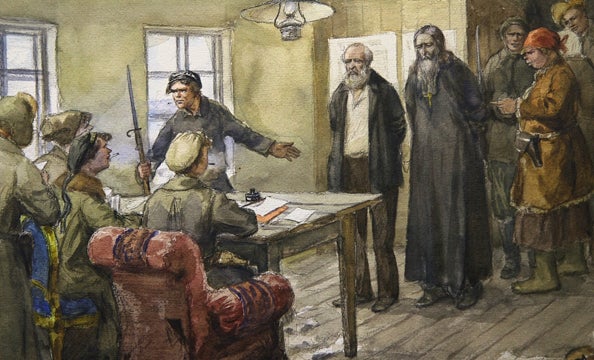|
View video here.
July 22, 2013
Hoover Library and Archives brings out its art to illustrate history
The archives of the Hoover Institution has amassed quite a collection over 90 years. Its latest exhibit sheds a colorful light on history by displaying works of art by amateurs and professionals alike. By Kurt Hickman

The exhibit showcases a wide range of items, from World War I photos to paintings of revolutionary Russia. (Photo by Kurt Hickman / Stanford News Service)
Archives are often pictured as rooms full of dusty books and documents – a place only for historians. The Hoover Institution is proving that theory wrong with its latest exhibit, Art and History: Treasures from the Hoover Library and Archives.
Presenting history in all its many shades, the exhibit showcases a wide range of items from the 20th century. From World War I photos to paintings of revolutionary Russia, the items capture many of the significant events of the past 100 years.
With the help of his colleagues, Nick Siekierski, a Hoover assistant archivist for exhibits and outreach, dug through 90 years of material to come up with some of the most visually appealing items.
"Most of what we collect is historical documentation," he explained. "Researchers come to the archives to do research and write books. What we are doing here is a different take on our collection. Because there is a visual aspect, the items present a different view on history."
Many of the items give historical events a personal touch. One display features hand-painted letters of gratitude sent to Herbert Hoover by Polish schoolchildren. After World War I, Hoover organized the American Relief Administration, which provided millions of dollars in humanitarian and food aid to Poland and other central European countries.
"These letters are both beautiful in their artistic value and they have a very sentimental and moving aspect to them," said Siekierski. "It shows how something that is visually appealing is also in fact deeply meaningful and a representation of a life-saving endeavor."
Another display comes from the institution's collection of Bertram Wolfe papers. Wolfe was a founder of the American Communist Party, and he and his wife were friends with artists Frida Kahlo and her husband, Diego Rivera. Taken from a wealth of correspondence is a letter Kahlo signs with lipstick and another she draws on, depicting herself "crying in a sea of sorrow."
"So while these aren't paintings by Frida Kahlo," said Siekierski, "they have a certain artistic aspect and you could say we have several Frida Kahlo originals."
Other selections include political cartoons by Chinese artist Jack Chen, botanical drawings from a Russian expedition to California in the 19th century and sketches of life in the gulag by Thomas Sgovio.
The exhibit is open to the public Tuesday through Saturday, 11 a.m. to 4 p.m., and is free of charge. It runs through Dec. 20.
-30-
|